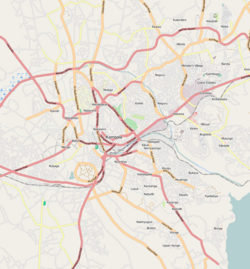
Back سقوط كامبالا Arabic سقوط کامپالا Persian Bataille de Kampala French Jatuhnya Kampala ID Queda de Campala Portuguese
| Fall of Kampala | |||||||||
|---|---|---|---|---|---|---|---|---|---|
| Part of the Uganda–Tanzania War | |||||||||
 Map of Kampala | |||||||||
| |||||||||
| Belligerents | |||||||||
|
|
| ||||||||
| Commanders and leaders | |||||||||
|
|
| ||||||||
| Units involved | |||||||||
|
Chui Battalion Uganda Army Air Force Fatah |
205th Brigade 207th Brigade 208th Brigade | ||||||||
| Strength | |||||||||
| c. 1,000 soldiers |
3 Tanzanian brigades 1 UNLF battalion | ||||||||
| Casualties and losses | |||||||||
|
Dozens of Ugandan soldiers killed 500+ Ugandan soldiers captured Light Libyan casualties |
Light Tanzanian casualties 6+ UNLF soldiers killed | ||||||||
| Several dozen civilians may have been killed | |||||||||
The Fall of Kampala, also known as the Liberation of Kampala (Kiswahili: Kukombolewa kwa Kampala), was a battle during the Uganda–Tanzania War in 1979, in which the combined forces of Tanzania and the Uganda National Liberation Front (UNLF) attacked and captured the Ugandan capital, Kampala. As a result, Ugandan President Idi Amin was deposed, his forces were scattered, and a UNLF government was installed.
Amin had seized power in Uganda in 1971 and established a brutal dictatorship. Seven years later he attempted to invade Tanzania to the south. Tanzania repulsed the assault and launched a counter-attack into Ugandan territory. After routing the Ugandans and their Libyan allies in Entebbe, the Tanzanians revised their existing offensive designs for Kampala. The plans called for the 208th Brigade to advance from the south, spearheaded by Lieutenant Colonel Ben Msuya's 800-strong 19th Battalion, which was to secure the centre of the city. The 207th Brigade and a UNLF battalion were to attack from the west, while the 201st Brigade was to establish roadblocks to the north to prevent Ugandan units from withdrawing. An eastern corridor was left open to allow the Libyans to evacuate to Jinja and fly out of the country. Amin prepared for the defence of Kampala but fled through the gap.
The Tanzanians began their assault on the city on the morning of 10 April. The 19th Battalion moved cautiously down the Entebbe–Kampala road. Other battalions of the 208th advanced on Port Bell. The 201st Brigade established its roadblocks north of Kampala and intercepted both forces attempting to reinforce Kampala from Bombo and those attempting to effect a breakout. The 207th Brigade advanced from the west in tandem with the UNLF battalion, which secured Nateete and passed through Rubaga. One of the 207th's battalions seized Kasubi hill and the royal tomb of the Kabakas. The 19th Battalion encountered only sporadic resistance and was greeted by crowds of rejoicing civilians. Upon reaching Kampala's city centre, the unit, lacking maps, had trouble navigating the streets. The Tanzanians secured the radio station and set up a command post on Kololo hill. The UNLF battalion occupied Republic House—the Uganda Army's headquarters at the edge of the city—unopposed, but was unable to take the State Research Bureau at Nakasero. Men of the 207th and 208th Brigades seized the southern and western portions of the city. The few Libyan units in the area put up little resistance, most having retreated to Jinja.
By dawn on April 11, Tanzanian troops had cut off all routes out of Kampala, including the road to Jinja, and began eliminating remaining pockets of resistance. Some UNLF forces conducted revenge killings against suspected collaborators with the Amin regime, while others attacked Kakwa and Nubians, both ethnic groups that had benefited from the dictatorship. Later in the morning Tanzanian artillery bombarded parts of the city. The remaining Ugandan soldiers in the city desperately attempted to escape by changing into civilian clothes and requisitioning civilian vehicles. Casualty statistics are not exact, though Tanzanian losses are estimated to have been light, and dozens of Ugandan soldiers and civilians are believed to have died. The battle marked the first time in the recent history of the continent that an African state seized the capital of another African country and deposed its government. In the immediate aftermath, civilians engaged in rampant looting, despite the attempts of Tanzanian and UNLF troops to maintain order. A new Ugandan government was established by the UNLF. Though pro-Amin forces were left scattered and disjointed by the seizure of the capital, combat operations in the country continued until 3 June, when Tanzanian forces reached the Sudanese border and eliminated the last resistance.
© MMXXIII Rich X Search. We shall prevail. All rights reserved. Rich X Search